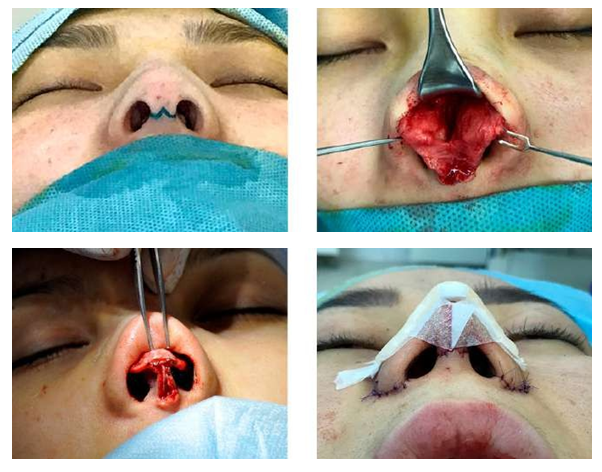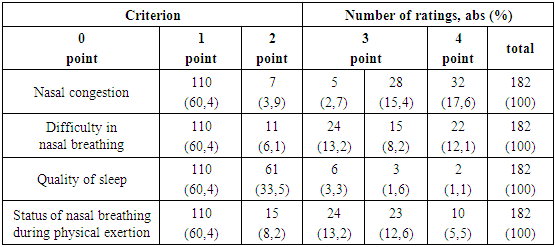-
Paper Information
- Next Paper
- Previous Paper
- Paper Submission
-
Journal Information
- About This Journal
- Editorial Board
- Current Issue
- Archive
- Author Guidelines
- Contact Us
American Journal of Medicine and Medical Sciences
p-ISSN: 2165-901X e-ISSN: 2165-9036
2025; 15(3): 551-553
doi:10.5923/j.ajmms.20251503.13
Received: Jan. 25, 2025; Accepted: Feb. 21, 2025; Published: Mar. 8, 2025

Features of Functional and Aesthetic Rhinoplasty
Oblokulov Fakhridin Odilovich
Academician of the Turon Academy of Sciences, Rhino Surgeon, Tashkent, Uzbekistan
Correspondence to: Oblokulov Fakhridin Odilovich, Academician of the Turon Academy of Sciences, Rhino Surgeon, Tashkent, Uzbekistan.
| Email: |  |
Copyright © 2025 The Author(s). Published by Scientific & Academic Publishing.
This work is licensed under the Creative Commons Attribution International License (CC BY).
http://creativecommons.org/licenses/by/4.0/

This article is dedicated to functional and aesthetic rhinoplasty, one of the most common procedures in plastic surgery. The author presents research findings that demonstrate how the proper selection of a rhinoplasty approach can significantly enhance surgical effectiveness and minimize risks for the patient. The study emphasizes the importance of individualized treatment plans and highlights the impact of nasal deformities on both appearance and respiratory function.
Keywords: Rhinoplasty, Functional rhinoplasty, Aesthetic rhinoplasty, Rhinoseptoplasty, Plastic surgery, Nasal deformity, Nasal breathing, Nasal obstruction
Cite this paper: Oblokulov Fakhridin Odilovich, Features of Functional and Aesthetic Rhinoplasty, American Journal of Medicine and Medical Sciences, Vol. 15 No. 3, 2025, pp. 551-553. doi: 10.5923/j.ajmms.20251503.13.
1. Introduction
- Today, rhinoplasty is one of the most widespread and popular plastic surgeries worldwide [1]. Its popularity can be attributed to the fact that reshaping or resizing the nose not only brings aesthetic enhancements by making facial features more refined but also significantly improves breathing function.According to the International Society of Aesthetic Plastic Surgery (ISAPS), rhinoplasty ranks among the top five most sought-after plastic surgeries globally. In 2022, ISAPS published its Global Survey on Aesthetic/Cosmetic Procedures, revealing that the total number of procedures performed by plastic surgeons had increased by 19.3% compared to previous years [2].In 2020 alone, approximately 850,000 rhinoplasty procedures were performed worldwide. The primary indications for nasal surgery traditionally include congenital or acquired nasal deformities, post-traumatic nasal injuries, and difficulty in breathing.In today’s society, the demand for plastic surgery continues to grow steadily. People are paying increasing attention to their appearance and are willing to undergo surgical procedures to enhance their looks. Patients who seek aesthetic changes to their noses—such as reducing a dorsal hump, refining the nasal tip, straightening a crooked nose, or narrowing the nasal bridge—typically opt for cosmetic or aesthetic rhinoplasty.Unlike aesthetic rhinoplasty, functional rhinoplasty is primarily aimed at improving nasal breathing and olfactory function without altering the nose’s external shape. In most cases, functional improvements can be achieved without significant external modifications, such as through septoplasty or certain techniques to correct vestibular stenosis (nasal valve dysfunction).Many patients wish to maintain their natural nasal shape, and in such cases, the plastic surgeon’s goal is to enhance nasal function and expand the internal airways while preserving the nose’s unique external appearance.Reconstructive rhinoplasty is required in cases of congenital or acquired nasal deformities where external structural changes are necessary to restore or improve both nasal function and form. These reconstructive procedures aim to return the nose to its pre-morbid state and should not be considered elective cosmetic surgeries.Examples of such cases include: Cleft lip-associated nasal deformities, Long-standing post-traumatic nasal injuries, Severe congenital nasal abnormalities.In these situations, modifying the nose's shape is a necessity, as the primary objective is reconstruction and restoration, rather than purely cosmetic enhancement.In all modern types of rhinoplasty, even in surgeries aimed solely at cosmetic modifications, it is crucial for the surgeon to inform the patient before the procedure that maintaining or improving nasal breathing is of primary importance.Surgeons must fully understand and clearly explain to their patients that excessively aggressive narrowing of the upper, middle, or lower thirds of the nose can lead to persistent nasal obstruction symptoms, significantly impacting the patient's quality of life [3].According to scientific literature, reports indicate varying rates of functional impairments following cosmetic rhinoplasty, with figures ranging from 15% to 68% [1; Yu et al., 2010]. Among these complications, nasal airway obstruction remains the most common reason for revision surgery [4].Thus, balancing aesthetics with functionality is a critical aspect of rhinoplasty, requiring careful surgical planning to achieve both visual harmony and optimal respiratory function.
2. Results and Discussion
- During rhinoplasty, various parts of the nose can be reshaped and corrected, including the nasal bridge, alar wings, and nasal tip. The procedure can be performed using either an open or closed approach, with the choice depending on the specific clinical case and the surgeon’s decision. Open rhinoplasty is considered the classical technique in nasal plastic surgery. The history of modern aesthetic nasal surgery began with this approach, and to this day, many rhinoplastic surgeons prefer open access due to its proven effectiveness, precision, and reliable post-operative outcomes.The open method provides: Excellent visibility and access to nasal structures, High surgical accuracy in reshaping complex deformities, A well-established approach with predictable outcomes, A smooth post-operative recovery process.For these reasons, our clinic also performs rhinoplasty using the open technique, ensuring high-quality results and patient satisfaction. A total of 182 patients (80 men and 102 women, average age 32±3.0 years) who underwent rhinoplasty for aesthetic reasons at different times (from 1 to 3 years ago) were examined. All patients subjectively assessed the aesthetic results of rhinoplasty and the state of nasal breathing at the examination stage using questionnaires. Since nasal obstruction is the most significant of the functional problems that arise after rhinoplasty, we used the previously well-proven NOSE (Nasal Obstruction Symptom Evaluation) questionnaire [5].
 | Figure 1. Stages of open rhinoplasty approach |
|
3. Conclusions
- In conclusion, it is essential to emphasize that rhinoplasty is not merely a cosmetic procedure that alters the shape of the nose, but rather a complex and sequential process aimed at correcting both aesthetic and functional issues for each individual patient.Rhinoplasty is a highly personalized surgery, tailored to address the specific needs and concerns of every individual. Given this, a surgeon must possess not only technical surgical expertise but also a deep understanding of psychology. It is crucial to recognize that form and function are inseparable, and achieving a perfect nasal shape is impossible if the nasal function is compromised.Rhinoplasty is a technically demanding procedure that requires a high level of expertise, deep anatomical knowledge, and experience in handling various nuances. Depending on the goal of the nasal reshaping, the procedure may involve: Restructuring the nasal shape, Adjusting the nasal angle, Resecting excess bone or soft tissues.A successful rhinoplasty does not simply involve enhancing nasal aesthetics—it must also preserve facial harmony and maintain the patient's unique individuality.The selection of the surgical technique is one of the most crucial steps in achieving the desired outcome. The integration of new technologies in surgical practice enables more precise corrections, reduces the risk of complications, and accelerates recovery, thereby ensuring optimal results. A combination of traditional surgical methods and advanced ultrasonic technologies has proven to be an optimal approach in modern rhinoplasty.Rhinoplasty remains one of the most popular plastic surgery procedures worldwide. Patients seek functional and/or aesthetic rhinoplasty for various reasons, whether to improve breathing or to enhance facial appearance. However, before performing surgery, the surgeon must carefully evaluate not only the patient's desires but also their nasal anatomy to determine what changes can be made safely without compromising health or functionality.
 Abstract
Abstract Reference
Reference Full-Text PDF
Full-Text PDF Full-text HTML
Full-text HTML